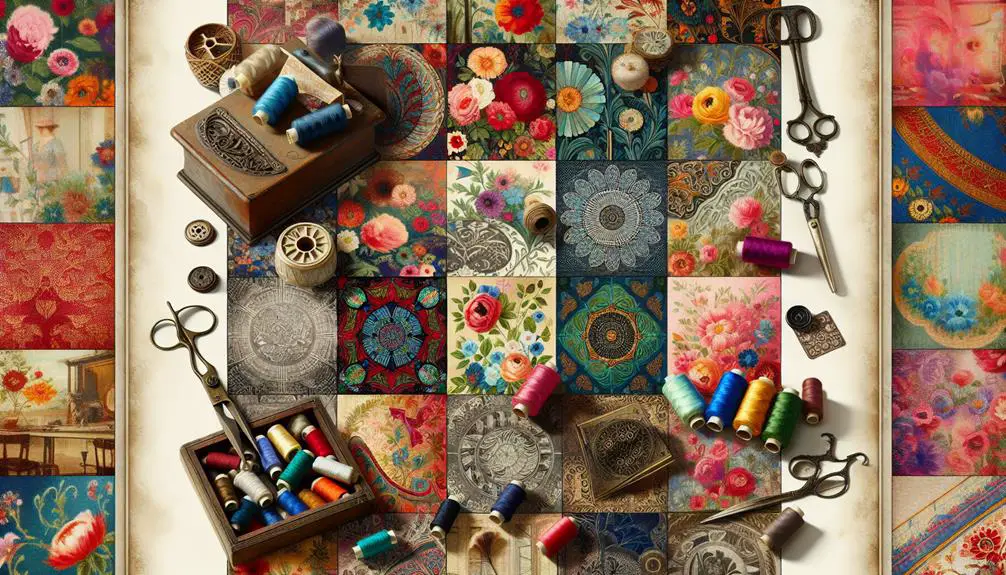Imagine Mariano Fortuny's atelier in Venice, where luxurious silks and intricate patterns were born, much like a master chef creating a culinary masterpiece from diverse ingredients. You can't ignore how his blend of ancient craftsmanship and modern innovation set a precedent in the textile world. Zandra Rhodes takes it further with her bold prints, using color psychology to push boundaries in fashion. Then there's William Morris, whose nature-inspired designs and eco-friendly practices revolutionized textiles. But what about Sonia Delaunay's geometric patterns or Liberty of London's timeless fabrics? Each designer contributes uniquely, shaping the textiles we see today.
Table of Contents
Key Takeaways
- Mariano Fortuny's luxurious silks with intricate patterns and vibrant colors blended ancient craftsmanship with innovative techniques.
- Zandra Rhodes pushed traditional textile design boundaries with vibrant prints and innovative techniques.
- William Morris's nature-inspired designs and eco-friendly dyes revolutionized the textile industry.
- Sonia Delaunay introduced bold colors and geometric patterns, integrating fine art into textile design.
- Liberty of London fabrics are renowned for timeless patterns, quality craftsmanship, and versatility across styles.
Mariano Fortuny's Luxurious Silks
Mariano Fortuny's luxurious silks revolutionized textile design with their intricate patterns and vibrant colors. As an influential designer, Fortuny didn't just create fabric; he crafted a legacy. His work is a brilliant symphony of art and technology, blending ancient craftsmanship with innovative techniques.
You'll admire how he drew inspiration from various cultures, integrating Renaissance and Oriental motifs into his designs. This fusion resulted in textiles that weren't only visually stunning but also technically advanced.
To truly appreciate Fortuny's genius, you need to explore the complexity of his intricate patterns. Each piece he produced was a meticulous labor of love, involving multiple stages of dyeing and printing. The patterns weren't just decorative; they told stories and evoked emotions, making each fabric a masterpiece.
Imagine the skill required to maintain such consistency and detail in every yard of silk.
Zandra Rhodes' Vibrant Prints
Zandra Rhodes' vibrant prints burst with color and creativity, transforming textiles into bold statements of fashion. You can't help but be captivated by her innovative approach to textile design. Her work isn't just about aesthetics; it's a masterclass in color psychology and its impact on fashion.
Rhodes has made significant contributions through her fashion collaborations and textile innovation. By partnering with high-profile fashion houses, she's brought her unique prints to the forefront of the industry. Her designs don't just walk the runway; they command it, leaving a lasting impact that's hard to ignore.
To fully appreciate Rhodes' influence, consider these key aspects:
- Fashion Collaborations: She's worked with major designers and brands, ensuring her prints reach a global audience.
- Textile Innovation: Rhodes' techniques push the boundaries of traditional textile design, incorporating unconventional methods and materials.
- Runway Impact: Her creations are a demonstration of the power of color psychology, evoking emotions and making bold statements that resonate with both audiences and critics.
William Morris' Iconic Patterns
When you look at William Morris' iconic patterns, you'll notice the intricate nature-inspired design elements that define his work.
His influence on modern textiles is undeniable, shaping both fabric design and production techniques.
Morris' legacy continues to thrive in interior design, infusing spaces with timeless elegance.
Nature-Inspired Design Elements
William Morris' iconic patterns, deeply inspired by nature, revolutionized the textile industry with their intricate designs and timeless appeal. When you explore his work, you'll encounter a rich tapestry of botanical motifs and sustainable fabrics that have set a high standard for textile design. Morris' attention to detail and commitment to eco-conscious practices make his contributions particularly relevant today.
Consider these key elements that define his nature-inspired designs:
- Botanical Motifs: Morris expertly integrated elements like flowers, leaves, and vines into his designs, creating visually stunning and harmonious patterns. These motifs not only capture the beauty of nature but also emphasize the importance of sustainable fabrics in modern design.
- Organic Textures: By using natural materials and techniques, Morris achieved a tactile quality in his textiles. The organic textures he created are a proof of his dedication to craftsmanship and ecological responsibility.
- Eco-Friendly Dyes: Morris was a pioneer in using natural, eco-conscious dyes. These environmentally aware choices have guaranteed that his designs remain both beautiful and sustainable, resonating with today's focus on green living.
Influence on Modern Textiles
Drawing from Morris' iconic patterns, modern textile designers continue to innovate by blending traditional motifs with contemporary techniques. You'll notice that today's designers aren't just replicating Morris' work but are reimagining it through sustainable innovation. By integrating advanced textile technology, they're creating fabrics that aren't only aesthetically pleasing but also environmentally friendly.
As you explore further, you'll find that Morris' intricate designs offer a rich foundation for artistic expression. However, it's essential to navigate the fine line between inspiration and cultural appropriation. When designers respect the origins of these patterns and give proper credit, they enrich the cultural tapestry of modern textiles rather than diminish it.
Moreover, today's textile technology enables you to explore a myriad of possibilities—consider digital printing and eco-friendly dyes. These advancements allow you to maintain the integrity of Morris' detailed patterns while ensuring sustainable production practices. This balance of heritage and innovation is what sets apart modern textile design.
In essence, Morris' legacy continues to influence, but your role is to push boundaries responsibly. By doing so, you'll contribute to a future where tradition and technology coexist harmoniously, making textiles an ever-evolving art form.
Legacy in Interior Design
Morris' iconic patterns have left an unforgettable mark on interior design, seamlessly blending artistry with functionality. When you explore his work, you can see how his designs transcend time, influencing both historical and contemporary spaces with equal grace. His patterns aren't just beautiful; they tell a story of meticulous craftsmanship and timeless elegance.
Here's why Morris' work continues to captivate:
- Impact on Fashion, Historical Significance: Morris' patterns have spread beyond interiors, making a significant impact on fashion. His designs are celebrated for their historical importance, often revisited in modern textile collections.
- Influence on Art, Contemporary Relevance: Morris' artistry extends to the broader field of visual arts. His influence is apparent in contemporary designs, where you can see reflections of his intricate patterns and natural motifs.
- Versatility and Functionality: His designs are versatile, fitting seamlessly into various settings—from classic Victorian homes to modern minimalist spaces. The functionality of his patterns guarantees they remain relevant, adaptable to different interior styles.
Sonia Delaunay's Abstract Designs
Sonia Delaunay's abstract designs revolutionized the textile industry with their bold colors and geometric patterns. You can't ignore the way she used geometric shapes to create dynamic and visually arresting fabrics. Her vivid, bold colors combined with these shapes transformed ordinary textiles into pieces of art. By breaking away from traditional patterns, she introduced a new visual language in textiles that emphasized movement and rhythm.
If you're aiming to master textile design, studying Delaunay's work is essential. She didn't just stick to one type of fabric or palette; she explored various materials and color combinations. Her innovative approach challenged conventional aesthetics and pushed boundaries. By integrating her knowledge of painting into fabric design, she created a seamless blend of fine art and practical application.
Delaunay's influence extends beyond just her fabrics; her abstract designs have inspired countless designers and artists. Her approach invites you to think outside the box and encourages you to experiment with shapes and colors fearlessly. If you want to elevate your own designs, embracing her principles of boldness and abstraction can lead you to create textiles that aren't only visually stunning but also groundbreaking.
Liberty of London's Timeless Fabrics
For over a century, Liberty of London's timeless fabrics have captivated designers and enthusiasts alike with their intricate patterns and high-quality materials. When you think of Liberty, you envision a brand that seamlessly blends timeless elegance with classic patterns, making their textiles an indispensable part of the design world.
You should consider three key aspects that make Liberty of London fabrics exceptional:
- Historical Legacy: Since its founding in 1875, Liberty has maintained a rich tradition of producing fabrics that never go out of style. Their archives house thousands of classic patterns that continue to inspire contemporary designers.
- Unparalleled Quality: Liberty fabrics are renowned for their superior quality. The brand uses only the finest cotton, ensuring that each fabric not only looks stunning but also feels luxurious and lasts for years.
- Innovative Designs: Despite their deep-rooted history, Liberty continually innovates. They frequently collaborate with modern artists and designers to create fresh, yet timeless, patterns that appeal to both traditional and modern tastes.
Alexander Girard's Playful Textiles
Alexander Girard's fabrics burst with playful designs and vibrant colors, capturing the essence of mid-century modern style. As you explore Girard's creations, you'll discover a world where whimsical patterns reign supreme. His designs often showcase abstract shapes, strong lines, and a lively color scheme, evoking a sense of joy and curiosity. Girard's whimsical patterns, influenced by diverse cultures and traditional art, challenge traditional standards and bring a sense of excitement to the textile realm.
You can observe how Girard embraced textile creativity through a playful approach. He wasn't hesitant to experiment, merging geometric shapes with natural patterns to produce visually engaging pieces. His method transformed textiles from simple functional items into enchanting pieces of art. By infusing his designs with a lively essence, Girard invited viewers to perceive fabrics from a fresh perspective, fostering an emotional bond with the patterns and hues.
In mastering Girard's methods, take note of how he harmonized intricacy with simplicity. His skill in making complex designs appear effortless is a sign of his brilliance. Girard's fabrics continue to inspire, demonstrating that playfulness and innovation can transform how we encounter and value fabric.
Iris Van Herpen's Futuristic Materials
Pioneering the fusion of fashion and technology, Iris Van Herpen's futuristic materials redefine the boundaries of textile design. Her innovative materials and avant-garde fashion push the limits of what's possible, creating garments that seem more like living sculptures than traditional clothing.
You'll be amazed by how she combines high-tech textiles with sustainable design principles to craft pieces that aren't only visually stunning but also environmentally responsible.
To appreciate Van Herpen's impact, consider these key innovations:
- 3D Printing: Van Herpen was one of the first to integrate 3D printing in her collections, creating intricate designs that would be impossible to achieve by hand.
- Magnetic Fabrication: She's also experimented with materials manipulated by magnets, resulting in dynamic, ever-changing textiles that respond to movement and environment.
- Biomimicry: Drawing inspiration from nature, Van Herpen uses high-tech textiles to mimic organic forms, creating sustainable designs that echo the natural world.
Frequently Asked Questions
How Has Technology Influenced Modern Fabric Design?
Imagine the canvas of fabric design painted by technology's brush. You're seeing digital printing sparking innovation, while sustainable practices and ethical sourcing weave a more responsible future. You're mastering a craft revolutionized by these advancements.
What Role Do Sustainability and Ethics Play in Fabric Design Today?
You'll find that sustainability and ethics in design are essential today. They minimize environmental impact and promote fair trade practices, ensuring your fabric choices support both the planet and ethical labor standards.
How Can I Start a Career in Textile Design?
To start a career in textile design, you should secure textile internships to gain industry experience. Develop a strong design portfolio showcasing your skills and creativity. Continuous learning and networking are key to mastering the field.
What Are the Latest Trends in Fabric Design?
You're curious about the latest trends in fabric design. Bold color palettes and intricate pattern repeats dominate. Fabric innovation is key, with eco-friendly fibers gaining popularity. Stay updated to master these emerging trends and elevate your designs.
How Do Cultural Influences Shape Fabric Design?
Cultural influences are the heartbeat of fabric design. You'll see historical significance woven into every pattern, reflecting traditions and stories. Mastering this art means recognizing and celebrating diverse backgrounds, ensuring designs are rich and meaningful.
- Tetron Fabric for Marine Applications: Durability and Use Cases - June 18, 2025
- Tetron Fabric for Outdoor Furniture: Weather Resistance and Care - June 18, 2025
- Tetron Fabric for Wall Coverings: Style and Application Tips - June 18, 2025







